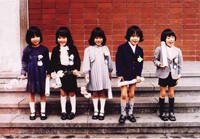|
Japan and the world
In the 1980's, the nation's attention turned
to the ways in which society was being distorted by various problems
involving land, health care and education. Strained international relations
in connection with trade and agriculture also caused concern. The series
The Japanese Condition addressed these
issues and questioned which way Japan was headed. That
Day in Japan, 1995, projected circumstances 10 years down the
road, using dramatization techniques to highlight aspects of employment,
aging, and health care.
Japan in the
World: Warnings from America, broadcast in three parts on successive
nights, took a long look at America's impatience and irritation with
Japan. This presentation, co-produced with ABC and PBS of the United
States, featured such innovations as a U.S. reporter interviewing Americans
in a program made for Japanese TV.
The next series was Japan in the World:
Who Does the Land Belong To?, which
addressed land-related issues in three parts. This evoked a remarkable
viewer reaction, with 23,000 calls in three days, and a five-part follow-up
series was produced.
Future alert
N-Toku never hesitated to examine problems
relating to science and technology, war, natural resources and the environment.
The Nuclear Age
revealed the nuclear strategies of the U.S. and U.S.S.R. when they were
still locked in the Cold War struggle. The series depicted nuclear war
from every angle and assessed the potential for nuclear weapons to prevent
future wars.
The World after
Nuclear War used the latest TV technologies to present the effects
and aftermath of a nuclear war. The program received the Prix Italia
along with several other awards.
Sea Lanes: Ocean
Defense Strategy introduced submarine sonar technologies and
activities of the U.S. Seventh Fleet, focusing on the defense of sea
lanes used to transport oil.
|
|
The series Warning
for the 21st Century considered the future of humanity from the
perspective of global coexistence. It called attention to dark clouds
gathering over the future of the human race, sounding the alarm about
the population explosion, dwindling food supplies and natural resources,
environmental destruction and the extinction of species, the collapse
of families and alienation of the younger generation.
The Silk Road: a mighty landmark
From the first broadcast of The
Silk Road: Distant Chang'an on April 7, 1980, to the airing of
the final episode, The Silk Road of the Sea:
Return to Chang'an on March 26, 1989, The
Silk Road spanned 10 years. At 42 episodes, it was the longest
N-Toku series ever undertaken.
The series guided viewers through the Eurasian
interior, exploring wilderness, ruins and oases as well as introducing
a wide variety of people and customs as it journeyed as far west as
Rome. The audience was captivated, and The
Silk Road came to be regarded as the quintessential N-Toku production.
The pattern established by The
Silk Road served to inspire other major documentaries on cultural
and natural wonders, including The Yellow
River and The Miracle Planet.
|
Human dramas
Starting with Quintuplets, a
series that chronicled the growth of its eponymous family, NHK
Tokushu broadcast numerous "human documentaries" about
life and death.
In 1981, Kozue: Age 20 featured
Yoshimori Kozue, a girl who was born without arms as a result
of thalidomide poisoning. The program followed her experiences
from childhood until a trip to Europe in the autumn of her 20th
year, revealing her indomitable spirit and positive outlook on
life.

Quintuplets: Age Six
|
Major Programs of NHK Tokushu 1982-88
|


